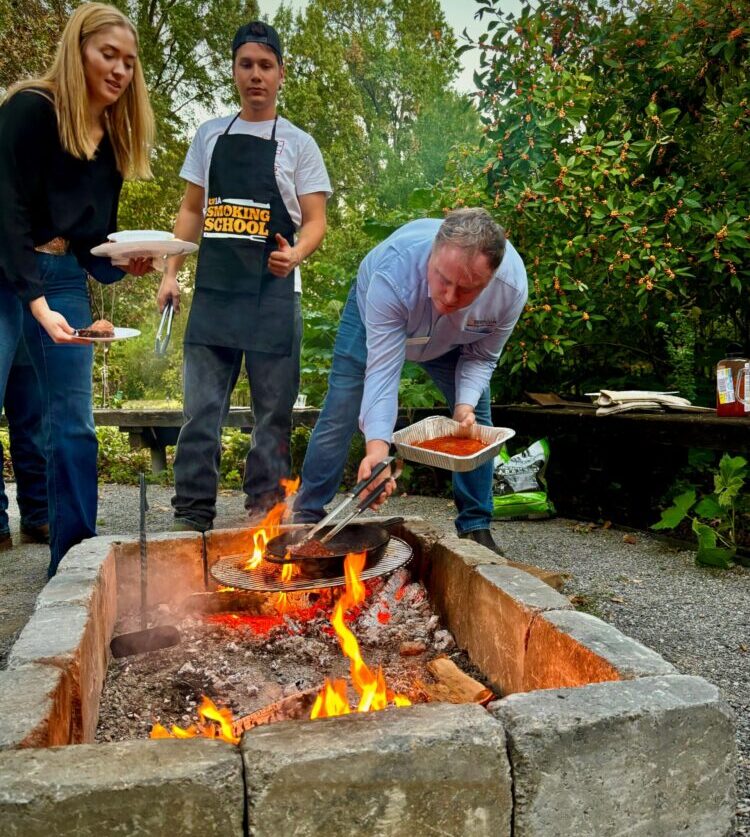
A great way to spend a summer evening is grilling steaks and watching baseball. To have an all-star experience while grilling, follow these tips for a safe and delicious meal at home.
Cut Selection & Cooking Tips
For tender, flavorful cuts, select steaks from the middle meats of beef, such as the ribeye steak, tenderloin steak, or strip loin steak. These cuts are from supportive muscles in the middle of the animal, which help support the spine of the animal, rather than move the animal around, like locomotive muscles in the shoulder or hindquarter. Supportive muscles, like those that make up the ribeye, tenderloin, and strip loin steak are tender, flavorful and easy to cook. They contain less connective tissue, smaller muscle fibers, and more marbling, which is the kind of fat that brings flavor and juiciness to the party. Steaks like these should be cooked quickly over a high temperature grill or cast-iron pan (350-500 degrees Fahrenheit (F)) at about 6-8 minutes per side, depending on steak thickness.
Cuts from the round (hindquarter) and chuck (shoulder) are locomotive and perform most animal movement, so they contain greater amounts of connective tissue and larger muscle fibers, which contributes to tougher cuts. However, some budget friendly options exist in the chuck for grilling season such as the chuck eye steak, Denver steak, Sierra steak, or the flat iron steak. These steaks offer more marbling than other chuck cuts, which helps improve flavor, tenderness, and juiciness of these cuts. For example, the chuck eye steak, also known as the Delmonico steak or a “poor man’s” ribeye, offers the flavor and marbling of a ribeye, but is smaller in size and cut directly anterior to the traditional ribeye roll, which can be cut into ribeye steaks.
Cuts from the locomotive muscles from the round and chuck typically perform better as roasts cooked low and slow in a slow cooker or on a smoker to allow for connective tissue to break down and become more tender. A chuck arm roast cut into cubes and smoked with your choice of barbecue sauce is also a great option for whipping up some burnt ends without the time, price tag, or experience needed to smoke brisket properly. The marbling with an arm roast offers great flavor development and taste after being smoked low and slow. To achieve the delicious bark seen in brisket burnt ends, season with your chuck roast with your desired seasoning blend, then smoke at 275 degrees F until the internal temperature reaches 165 degrees F. Hickory, mesquite, or oak will make great smoking wood to complement the flavors of beef. Following this period, wrap the chuck roast in butcher paper or foil and smoke until the roast reaches 195 degrees Fahrenheit internally. Remove from heat and rest for 15 minutes, then cube the roast into about 2-inch cubes. Place the cubes in a foil pan and add about 8 oz of your favorite sweet, Kansas City style BBQ sauce with about ¼ cup of brown sugar. Cover with foil and place the foil pan back on the smoker, then continue to smoke for an additional 2 hours. Add 2 tablespoons of brown sugar and an additional 4-8 oz of BBQ sauce. Heat through on the grill and enjoy!
Keep it Cold, Clean, and Safe
When preparing a summertime meal, make sure to keep your raw meat separated from other foods by using different cutting boards, utensils, and knives. Keep meat in the refrigerator until it is preparation time. Additionally, after your meat is done cooking, change plates to keep raw and cooked meat separated at the grill. Hit a grand slam with food safety and quality by using a thermometer on your cooked meats. By using a thermometer, you not only hit the mark for a perfect degree of doneness, but it also keeps foodborne illness at bay. Steaks, chops, and roasts from beef, pork, or lamb should be cooked to a minimum of 145 degrees F internally (medium rare). Ground meats, like burgers, should be cooked to a minimum of 160 degrees F to be safe. Ground meats need a greater degree of doneness to be safely consumed due to the grinding process. Potential pathogens of concern could be on the surface of the trim used to make ground beef and then brought into the middle through the mixing and grinding process. Cooking burgers and other ground meats to 160 degrees F helps destroy the concerning bacteria and prevents foodborne illness from ruining a cookout.